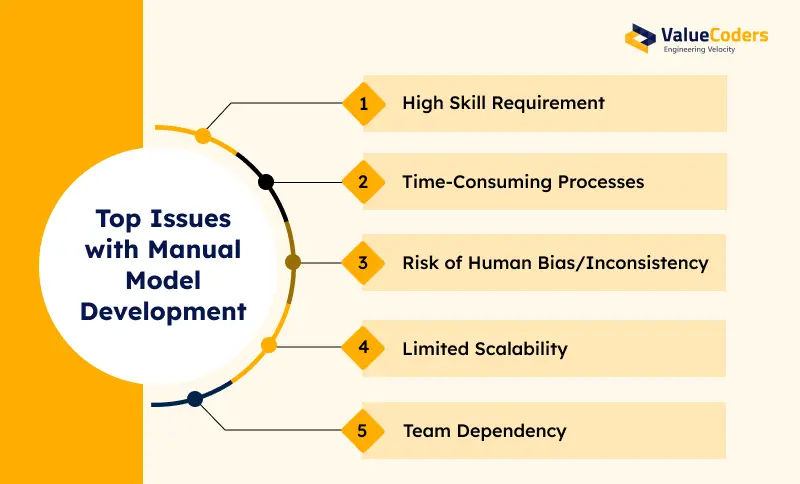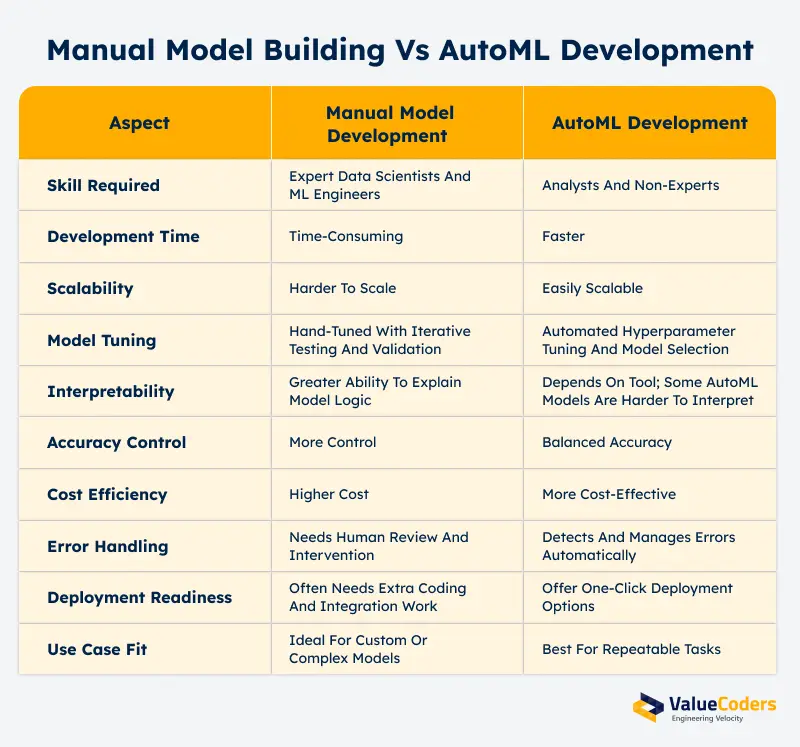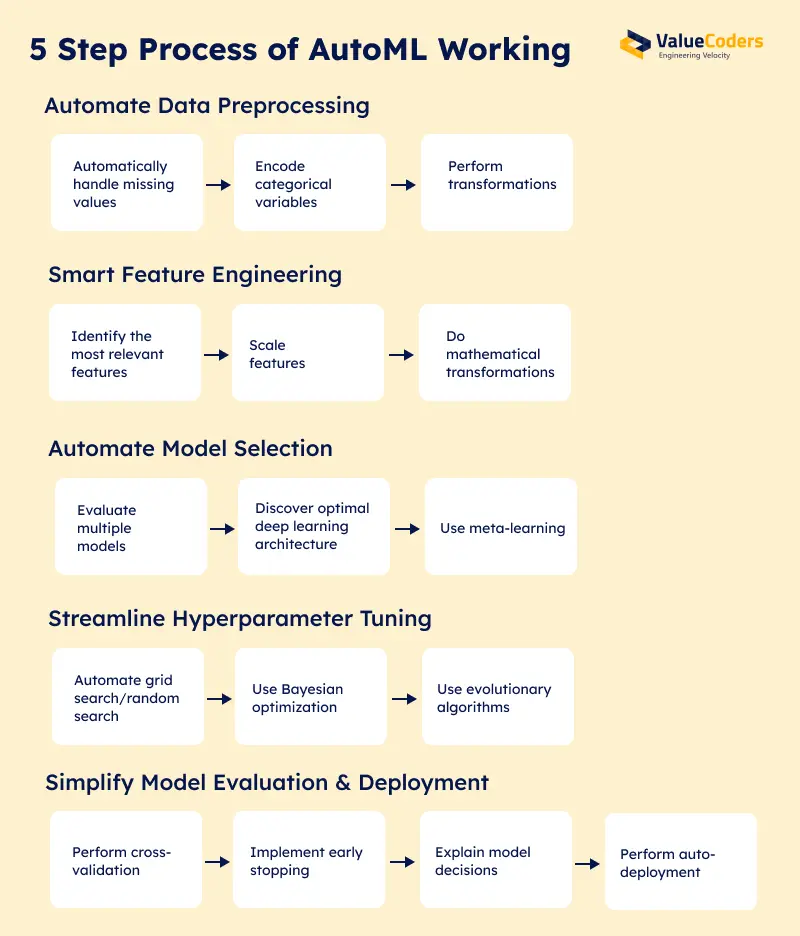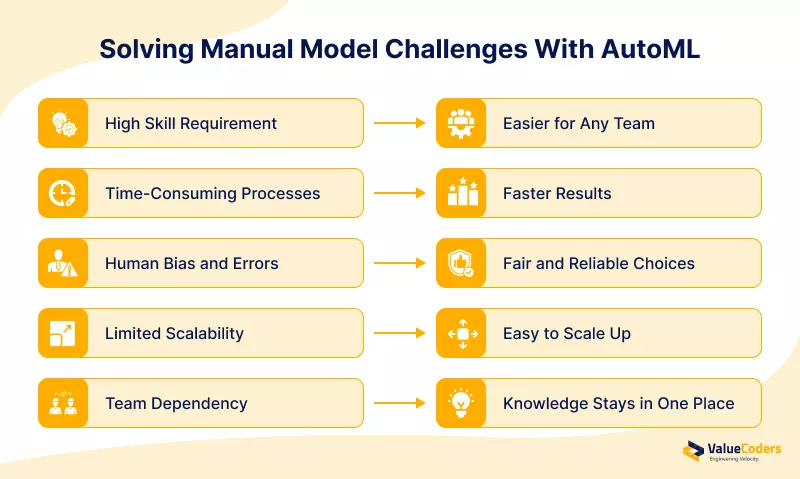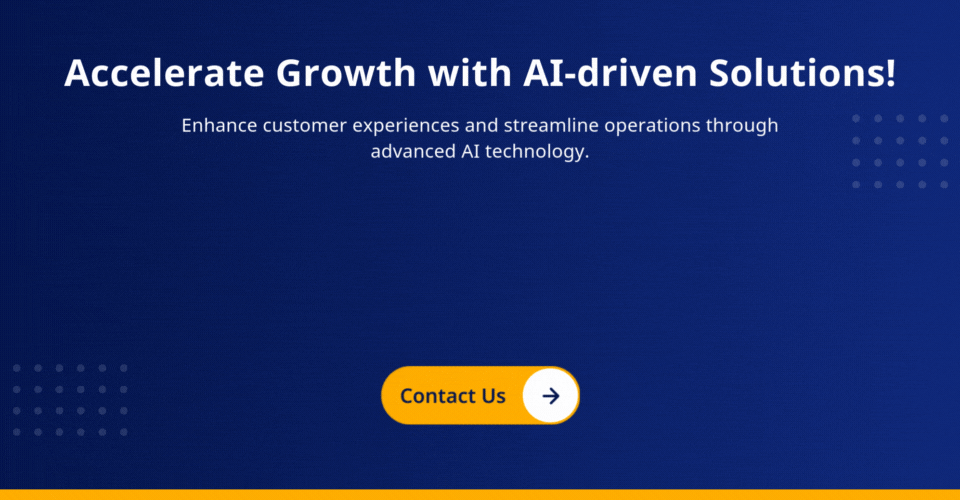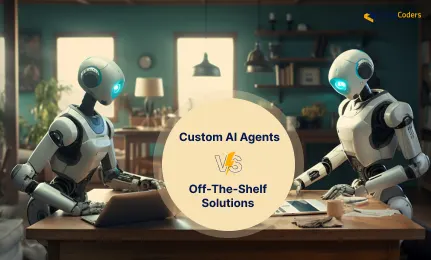Human intervention makes manual model building slow, complex, and resource-intensive.
Hence, the challenges are obvious:
- Limited scalability.
- Prolonged development cycles.
- Low business value.
Here, AutoML emerges as a solution that enhances the efficiency of traditional enterprises.
Such an automation empowers modernization leaders by enabling them to:
- Accelerate experimentation.
- Implement models more efficiently.
- Minimize operational downtime.
This blog helps you explore various facets of AutoML development. First, let us explore the possible issues that make manual model building a sub-optimal choice.
Top Challenges with Manual Model Building
Manual model building offers a traditional approach to creating Machine learning solutions. It needs top data experts to write code by hand. They further clean data, define features, and test different algorithms.
Moreover, data scientists spend weeks preparing it for use. They remove errors, fill in missing values, and format everything correctly. This is why manual model building faces several major challenges that slow down overall business progress.
Some of the top manual model-building issues are:
1. High Skill Requirement
It creates a bottleneck for most companies. Finding qualified data scientists is expensive and time-consuming. These experts command high salaries and are in short supply.
2. Time-Consuming Processes
This delayed project launches. A single model can take 3-6 months to build. Business needs change during this long development cycle.
3. Risk of Human Bias/Inconsistency
This affects the machine learning model quality. Different scientists make different choices. Moreover, personal preferences influence feature selection and algorithm picks.
4. Limited Scalability
This prevents growth. Manual methods work for one or two models. They break down when companies need dozens of models across different departments.
5. Team Dependency
This creates a business risk. When key scientists leave, projects stall. Knowledge stays locked in individual minds instead of company systems.
Reduce development time by 60% with our AutoML development services, used by 200+ clients across 9 industries.
Manual Model Building vs AutoML Development: Key Comparison
While comparing “manual vs automated model building”, both approaches have distinct features depending on the project’s goals, complexity, and resources. However, there are multiple advantages of AutoML as compared to manual model building.
Some of the key parameters used for key comparison:
1. Skill Requirement
Manual Model Building demands deep expertise in statistics, programming, and domain knowledge. Data scientists need years of training. They must understand complex algorithms and when to use them.
AutoML requires a basic understanding of business problems and data. Users need to know what questions to ask, not how to code solutions. Technical skills are minimal.
2. Development Time
Manual Model Building takes 3-6 months for a single model. Data preparation alone consumes weeks. Testing and tuning extend timelines further.
AutoML completes models in hours or days. This is one of the main advantages of AutoML development. The system works continuously without breaks. Multiple models can be built simultaneously.
Deploy ML models 70% faster using our proven AutoML frameworks designed for quick integration into your stack.
3. Scalability
Manual Model Building struggles with multiple projects. Each model needs dedicated expert attention. Teams become bottlenecks as demand grows.
AutoML handles dozens of models with the same effort. The system scales automatically. Business units can work independently.
4. Accuracy Control
Manual Model Building allows fine-tuned control over every decision. Experts can adjust models based on domain knowledge. Custom algorithms are possible.
AutoML provides good accuracy for most problems. The system uses proven techniques. Custom adjustments are limited.
5. Cost Efficiency
Manual Model Building requires expensive data science teams. Salaries, benefits, and training costs add up quickly. Projects have high upfront costs.
AutoML uses existing team members. Software costs are predictable. Projects start with lower investment.
6. Deployment Speed
Manual Model Building requires additional work to prepare models for production. Integration takes weeks of additional development.
AutoML creates deployment-ready models automatically. APIs and documentation are generated. Models go live immediately.
7. Model Tuning
Manual Model Building allows unlimited customization. Experts can adjust every parameter. Models can be tailored to specific business needs.
AutoML provides good tuning automatically. The system finds optimal settings for your data. Manual adjustments are limited.
8. Interpretability
Manual Model Building provides full visibility into model decisions. Experts can explain every choice. Custom explanations are possible.
AutoML offers standard explanations and feature importance. The system provides basic interpretability. Deep customization is limited.
Collaborate with ValueCoders to implement automated machine learning solutions that drive real, measurable business transformation.
How AutoML Works?
AutoML makes AI model development faster and easier by following a series of automated steps. Overall, it is a 5-step process including:
1. Automate Data Preprocessing
The system starts by examining your data. It identifies data types, missing values, and quality issues. Cleaning happens automatically without human review. The system handles the following tasks in minutes, not days.
- Text data gets converted to numbers.
- Dates become usable features.
- Missing values are filled using smart techniques.
2. Smart Feature Engineering
AutoML creates new variables from existing data. It combines fields in useful ways. The system generates hundreds of potential features automatically.
- Mathematical transformations happen
- System creates ratios, averages, and other derived features
- Tests which combinations improve model performance.
3. Automate Model Selection
Multiple algorithms run simultaneously on your data. The system tests decision trees, random forests, and neural networks. Each algorithm gets a fair chance to prove its worth.
- Cross-validation ensures reliable results
- System splits data into training and testing sets
- Measures performance fairly across all algorithms
Also read: How AI in Business Process Automation is Changing the Game
4. Streamline Hyperparameter Tuning
Each algorithm has settings that affect performance. AutoML tests thousands of parameter combinations. It finds the best settings for your specific dataset.
- Completes the process in hours
- Uses smart search techniques
- Find good parameters quickly
5. Simplify Model Evaluation & Deployment
The system compares all models and picks the best one. It provides performance metrics and explanations. Models are ready for production use immediately.
- APIs are created automatically
- Documentation is generated for technical teams
- Model integrates easily with existing business systems
Deliver models in weeks, not months. Our AutoML pipelines are trusted by leading SaaS and fintech businesses.
How AutoML Addresses the Issues With Manual Model Building?
Building models manually takes time, costs more, and is hard to scale. AutoML fixes these problems by automating most of the tough steps while still giving you models that fit business needs.
Here is how AutoML solves the main issues with manual model building:
- High Skill Requirement → Easier for Any Team
AutoML tools are simple to use. Even teams without expert data scientists can build strong models. This reduces the need for rare, expensive talent. - Time-Consuming Processes → Faster Results
Tasks like data cleaning, feature selection, and testing models take months when done manually. AutoML does them in hours or days, helping you move faster. - Human Bias and Errors → Fair and Reliable Choices
Instead of relying on one person’s judgment, AutoML tests many algorithms at once and picks the best. This improves accuracy and consistency.
- Limited Scalability → Easy to Scale Up
Manual methods struggle when you need many models at the same time. AutoML builds and deploys multiple models together with the same effort. - Team Dependency → Knowledge Stays in One Place
AutoML keeps workflows and documentation within the platform. This means knowledge does not get lost if a team member leaves.
For early traditional enterprises, AutoML means faster progress, lower costs, and a system that grows with the business.
Also read: Integrating AI and Machine Learning into Business Operations
Conclusion
Automated machine learning solutions are transforming the way machine learning models are built, making AI more accessible, efficient, and scalable.
By automating complex tasks such as data preprocessing, feature engineering, and model selection, AutoML development aids businesses and data scientists in developing high-performing models with less time and effort.
While challenges like data quality and interpretability remain, the future of AutoML development looks promising, with advancements in deep learning automation, federated learning, and explainability.
Being a leading AI services company in India, ValueCoders provides robust AutoML solutions to our global clients. We offer services such as AutoML model tuning, consulting, featured engineering automation, MLOps, platform integration, etc. Contact us today!


